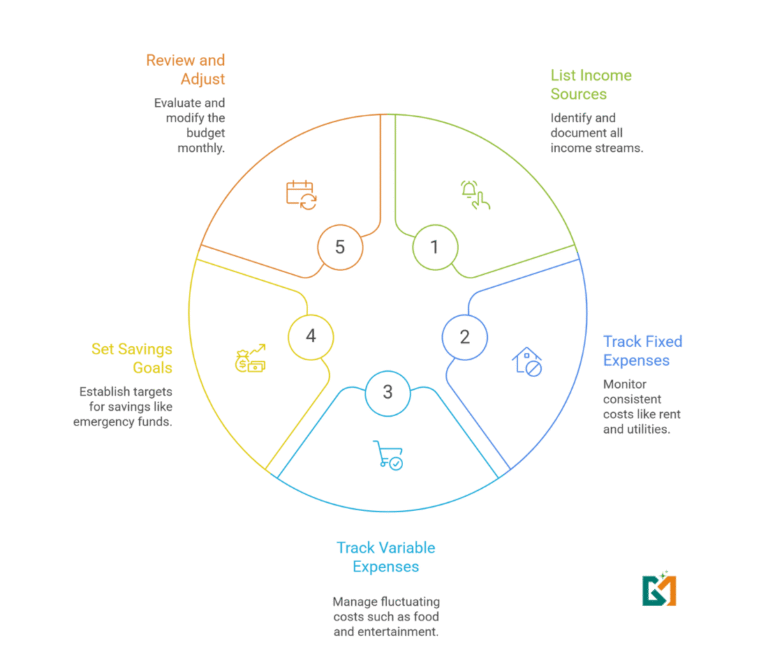Budgeting and saving
Practical steps to plan where your money goes and build savings that support both everyday needs and future goals.

Edited by: GlimMarket Editorial
Editors, Writers & Reviewers
|
- Published on
- Last Modified : September 11, 2025
Start Your Business- Support Resources for News Businesses



Manage Your Finance

Tools to Plan and Manage Your Small Business Finances
Free Templates and Downloadable Resources
Loan application checklists
Right people together made to challenge established thinking and drive transform
Step-by-Step Guides for Small Business Growth
How to apply for a small business loan
How to start a small business
How to build business credit
How to build business credit
Popular Resources and Recommendations
What Does Budgeting and Saving Really Mean?
Budgeting and saving are often spoken about together, yet they are not the same thing. Budgeting is about deciding, in advance, how you want to use the money you have. It is a plan that shows where every dollar should go, whether it is for rent, groceries, gas, paying off a loan, or even setting aside something for entertainment.
Saving, on the other hand, is about holding back a part of your income so that you have money to fall back on when life throws surprises, or when you want to reach a goal like buying a car, building a home, or retiring with some comfort.
Think of budgeting as drawing the map and saving as walking steadily toward a destination. Without a budget, it is easy to lose track of where your money slips away. Without savings, you may find yourself unprepared when emergencies come up or when an opportunity arrives that needs money in hand.
In daily life, this can look very simple. A family may set aside envelopes for groceries, transport, and bills so they never spend more than what is in each envelope. A young professional might decide that 10% of every paycheck will go straight into a savings account before anything else is spent.
Even a small business seller on GlimMarket recently shared with us how she separates her monthly marketplace earnings into two jars: one for reinvesting in her store and another just for personal savings. We have seen similar stories from our community, like a buyer who budgeted for home essentials using our deals to build an emergency fund. These small, consistent steps form the heart of budgeting and saving, and they make money feel like something you control instead of something that controls you.
Table of Contents
Why Budgeting and Saving Matter More Than Ever
The need to budget and save has always been there, but today it feels sharper because of the reality we live in. In the U.S., the cost of housing, groceries, healthcare and education has risen at a faster rate than wage growth in recent years. Inflation has made everyday expenses heavier, and debt levels for households remain high.
In this environment, people who do not have a budget often end up relying on credit cards or loans to fill the gaps, which makes their money situation even harder to manage in the long run.
Saving is equally critical. It is not only about creating an emergency cushion, though that is important. It is also about being ready when life brings opportunities. With some savings, you can say yes to a business idea, a career course, or even a chance to move to a better place. More importantly, having money set aside gives peace of mind, which cannot be measured in numbers. It reduces the stress that comes with the uncertainty of what tomorrow may bring.
In our work at GlimMarket, we have often seen that the biggest barrier to saving is not always income level. Many people with decent earnings still struggle to build savings because they have no clear plan. Without a budget, spending gets scattered and nothing is left at the end of the month.
On the other hand, even families with modest incomes can build steady savings if they carefully plan expenses and put savings first. This shows that the habit of budgeting and saving can be more powerful than income alone in shaping financial security.
“Building even a modest emergency fund is more than a money habit, it’s a lifeline. In 2025, over 50 percent of Americans say they still worry about covering surprise costs. A simple stash of cash gives real peace and control.”
— Sarah Bruder, Senior Personal Finance Editor, Investopedia.
Source: Investopedia, April 2025 survey via PYMNTS Intelligence and Splitit data.
The Basic Building Blocks of a Budget
A budget may sound complicated, but at its core it is just a clear picture of how money comes in and how it goes out. The first step is to list every source of income. For most people, this starts with a salary, but side work, freelance projects, or even money earned from selling items online also count. Knowing your full income is important, because many people underestimate how much they actually make or overestimate it and end up short.
The next part is to track fixed costs. These are expenses that stay the same each month such as rent or mortgage, utility bills, internet, car payments, and loan installments. Once fixed costs are written down, variable costs need to be included. These are the expenses that shift month to month like groceries, transport, clothing, or entertainment. They can be tricky, because this is often where overspending happens.
Finally, there should always be a place for savings in the budget. Many people treat savings as whatever is left after spending, but this often means there is nothing left to save. A stronger approach is to make savings a priority right from the beginning. Even 5% of income set aside first can grow into something meaningful over time.
The tool you use does not matter as much as the habit itself. Some people create spreadsheets with color coding, while others write expenses on paper or even keep a running list in their phone’s notes app. A simple handwritten list on a fridge has helped many households keep spending in check. The important thing is to stay consistent and review the budget often, because life and expenses keep changing.
Author Tip
Separate your “irregular expenses” early.
Most budgets fail because people ignore costs that do not come monthly but are inevitable, like annual car insurance, school fees or holiday spending. I always recommend creating a “hidden” savings bucket for these irregular bills. Even saving aside $40–$50 each month into this category makes the budget far more realistic and avoids the shock of once-a-year expenses.
Flow Chart: ‘How to Build a Simple Budget

Saving Made Practical: Small Steps That Work
Saving often feels overwhelming because people imagine it requires large sums. In reality, it works best when it begins with small, steady steps. Setting aside $20 each week, choosing a round-up savings app that moves spare change into a savings account, or skipping one extra coffee a day can all make a real difference over time. These actions may seem small in the moment, but they build habits and habits are what turn short-term choices into long-term results.
It helps to separate savings into short-term and long-term goals. Short-term savings could cover a holiday trip, a new laptop, or paying for car repairs without stress. Long-term savings are for bigger milestones such as a home down payment, children’s education, or retirement. Thinking in both timeframes gives direction and makes saving less abstract.
For beginners in the U.S., using the right tools makes saving easier. High-yield savings accounts allow money to grow faster compared to regular savings accounts, while Certificates of Deposit (CDs) lock funds for a set period in exchange for higher interest. These products are available at many banks and credit unions and can be opened online with minimal effort.
One GlimMarket user recently shared how she began saving just $25 a week from her marketplace sales. At first, it felt like too little to matter, but within a year she had over $1,200 set aside, enough to cover a family emergency without turning to credit. Stories like this remind us that small, practical steps, repeated with discipline, often create the strongest foundation for financial security.
Example
Maria, a 27-year-old graphic designer in Texas, felt she never had money left to save. Instead of aiming for a large savings target, she began with $25 every Friday moved automatically into a high-yield savings account. She treated it like a subscription fee she paid to herself. After six months, she had built $650. This small buffer later helped her cover a car repair without relying on a credit card.
Different Approaches to Budgeting
Budgeting is not one-size-fits-all. Different people prefer different systems, and what works for one family may not suit a single professional or a freelancer. Here are some of the most common and practical methods:
50/30/20 Rule
This rule suggests dividing income into three categories: 50% for needs like housing, utilities, and groceries, 30% for wants such as dining out or hobbies, and 20% for savings and debt repayment. It is simple to follow and works well for people who want an easy structure without tracking every little detail.
Zero-Based Budgeting
In this method, every single dollar has a job. At the start of the month, you assign income across all categories until nothing is left unallocated. This makes it easier to spot wasteful spending but requires more effort and regular tracking. Many businesses use this system, and it can be equally effective for households that want full control.
Envelope Method
This is one of the oldest and most disciplined methods. You put cash into physical envelopes marked for categories like groceries, gas, or dining out. Once the envelope is empty, you cannot spend more in that category until the next cycle. It is very effective for curbing overspending but may feel restrictive for people used to digital payments.
Digital Tools
Modern budgeting apps and online banking tools make tracking effortless. They link to bank accounts and credit cards, categorize spending automatically, and send alerts when you approach limits. For tech-savvy individuals, these tools can save time and give quick visibility into financial habits.
Table: Comparing Popular Budgeting Rules
| Method | How It Works | Best For | Drawback to Consider |
|---|---|---|---|
| 50/30/20 Rule | 50% for needs, 30% for wants, 20% for savings or debt repayment. | Beginners who want a simple structure to follow. | May not suit households with high housing or healthcare costs. |
| 70/20/10 Rule | 70% for living expenses, 20% for savings/debt, 10% for giving or investing. | Families in higher-cost areas where essentials take more of the budget. | Leaves less room for discretionary spending. |
| Zero-Based Budgeting | Every dollar is assigned to a category with nothing left unplanned. | People who want total control over money flow. | Time-consuming to track in detail. |
| Envelope Method | Cash is divided into envelopes for categories like food, gas, etc. Spending stops when envelope is empty. | Those who struggle with overspending. | Less practical in a digital, card-based world. |
Everyday Challenges People Face With Saving
While saving sounds straightforward on paper, the reality often feels different. Many people struggle not because they do not earn enough, but because life pulls them in many directions at once.
One major challenge today is the pressure from social media. People constantly see friends or influencers showing new gadgets, vacations, or luxury lifestyles. It creates a fear of missing out and makes spending feel like the only way to “keep up.” Over time, this habit can drain money that was meant for savings. A realistic way to handle this is to set clear personal goals, like building a vacation fund, so you stay focused on what matters to you instead of comparing with others.
Another common issue is unexpected bills. Car repairs, medical expenses, or sudden rent increases can wipe out progress. This is where having even a small emergency cushion of $500 to $1,000 can prevent setbacks from becoming crises.
Freelancers and gig workers often face irregular income. One month might bring more than enough, while the next month may fall short. In such cases, it helps to separate fixed monthly expenses and cover them first when income is higher. Some freelancers also use a second account to set aside tax money or lean months, so they avoid the trap of overspending during good months.
These struggles are real, and most people experience them at some point. In my experience working with GlimMarket users, starting with small wins like tracking one expense category builds momentum. The key is not to aim for perfection but to build flexible systems that adapt. Saving is not about never facing problems, it is about being better prepared when they arrive.
Author Tip
Budget your time alongside your money.
Over years of studying personal finance, I have seen how poor time management leads to poor money management. For example, eating from out frequently happens due to the lack of time to cook, not from overspending habits. If you block even 2–3 hours weekly for meal prep or shopping smart, you cut costs naturally. Pairing your money budget with a time budget gives a practical advantage most financial guides overlook.
Budgeting and Saving for Life Events
Life is full of big transitions that bring both joy and financial responsibility. Planning for these moments early makes the journey less stressful and reduces the need to depend on costly debt.
Marriage and Family
Weddings in the U.S. can easily cost tens of thousands of dollars. Beyond that, couples must think about shared living expenses and possibly children. Setting aside a “life events fund” years in advance can mean the difference between starting married life with savings or with credit card debt.
Buying a Home
A down payment, closing costs, and moving expenses often surprise first-time buyers. Building a targeted savings goal, such as 10–20% of the home price, creates a realistic pathway to ownership without being caught unprepared.
Having Children
The cost of raising a child in the U.S. is estimated at around $310,000 over 18 years, not including college. Planning savings for medical bills, childcare, and future education gives parents a sense of control and reduces stress when unexpected expenses arise.
In each of these cases, creating a separate fund dedicated to that event, apart from daily savings helps people stay disciplined and motivated. GlimMarket users often share how budgeting for these via our affordable listings eased the load.
According to the Federal Reserve’s 2025 Economic Well-Being survey, 55% of U.S. adults say they have enough savings to cover three months of expenses, a slight improvement from 54% in 2023 but still leaves many households exposed.
How Budgeting Builds Financial Confidence
Budgeting is not only about numbers on a spreadsheet. It is about creating a sense of security and confidence in daily life. When you know where your money is going, the feeling of uncertainty and worry fades.
A simple monthly plan can stop small worries from piling up. For example, tracking just five categories like housing, food, transportation, savings and personal spending, can already give a clear picture of financial health. That clarity reduces stress, especially when unexpected expenses come.
Research has shown a link between financial planning and overall well-being. People who actively budget are often less anxious about the future and feel more prepared for emergencies. Budgeting gives people the confidence to make bigger choices, such as switching jobs or starting a business, because they know their financial base is covered.
Quick Ways to Get Started Today
Taking the first step does not need to be complicated. Even small actions can put you on track toward better financial control:
- Write down your expenses for the past week. Seeing where the money went can be eye-opening and shows areas where you can adjust.
- Pick one budgeting method and try it for 30 days. Whether it is the 50/30/20 rule or a simple handwritten list, experimenting helps you find what fits best.
- Open a dedicated savings account. Automating even $25 or $50 a month builds a habit that grows over time.
Starting small but consistent is often more effective than setting ambitious goals and giving up quickly. The point is to create a system that you can keep for years, not just weeks.
Reviewer Insight

Founder, Senior Editor & Expert Reviewer at GlimMarket
What makes budgeting powerful is not its complexity, but its consistency. A simple monthly plan, followed carefully for years, can do more for financial security than any high-return investment made inconsistently. In my experience, I have seen middle-income families who stuck to basic rules like saving first or separating irregular expenses build emergency funds stronger than households earning double their income. It is this discipline, not income level alone, that creates stability. My advice has always been: start small, stay steady and let the habit compound.
Frequently Asked Questions
Saving $1000 in six months may sound challenging, but it becomes realistic when broken into small pieces. You need about $167 each month or a little over $40 a week. One way is to cut one or two non-essential expenses such as eating out twice a week or multiple streaming subscriptions.
Another option is to pick up a short freelance project or side hustle where even $50 extra a week goes straight into savings. Automating a transfer into a separate savings account as soon as your paycheck comes helps you stay disciplined. Many people are surprised to see that when savings are treated as a fixed bill, reaching $1000 feels far more achievable.
The 70/20/10 rule is another simple budgeting approach that helps people divide income into clear categories. Seventy percent of take-home pay goes toward living expenses such as housing, food, transportation, and utilities. Twenty percent is directed toward savings and debt repayment.
The final 10 percent is set aside for giving, investing, or other personal goals. Some find it easier than the 50/30/20 method because the majority is focused on essential costs, which mirrors the reality of higher living expenses in many U.S. households. It is not perfect for everyone, but it works well as a starting framework.
A good budget usually follows a sequence of steps that build on each other:
- List all income sources.
- Track every expense for at least one month.
- Group spending into categories such as housing, food, transportation, debt, and savings.
- Identify areas where spending can be reduced.
- Set short-term and long-term financial goals.
- Create a written or digital plan that assigns each dollar a role.
- Review the budget regularly and make adjustments when life changes.
Budgeting is not about creating a perfect plan once. It is about building a process you can adjust and trust over time.
The four walls is a concept popularized in personal finance teaching. It refers to covering four essential categories before spending on anything else: food, utilities, shelter, and transportation. These are the basics that keep a household running. When income is limited or debt is overwhelming, focusing on the four walls ensures stability and prevents falling behind on the most critical needs.
Once these are secure, then other goals like savings or entertainment can be added. This approach is often helpful for families trying to regain control after a financial setback.
For most people, the biggest wealth-building tool is their income. A steady paycheck, combined with the skills and career decisions that can grow it over time, provides the foundation for everything else. Investments, savings, and side hustles only multiply what is first earned.
Protecting income with continuous skill development, networking, and thoughtful career choices is one of the most overlooked but powerful ways to build wealth. The ability to earn consistently and increase earning power often matters more in the long run than chasing high investment returns.
There is no single number that works for everyone, but a healthy rule of thumb is to aim for at least 20 to 30 percent of income remaining after paying essential bills like housing, utilities, groceries, and minimum debt payments. This leftover amount should ideally go toward savings, debt repayment beyond the minimum, and personal goals.
If you consistently find that nothing is left, it may mean housing or lifestyle costs are too high compared to income. Adjusting expenses or finding ways to grow income can help create breathing space.
Paying yourself first means treating savings as the top priority, not as whatever is left over after spending. The easiest way is to set up an automatic transfer from checking to a savings account on payday. For example, if you decide to save 10 percent of income, that transfer happens before you even touch the money.
This method is helpful because it removes the temptation to spend first and save later. Over time, paying yourself first turns saving into a habit rather than a struggle. Even starting with a small amount like $25 per paycheck makes a difference once consistency builds.
A fixed expense is a cost that stays the same each month regardless of usage or lifestyle changes. Examples include rent or mortgage payments, car loans, insurance premiums, or subscription services with set fees. These are different from variable expenses like groceries or utilities that can change month to month.
Recognizing fixed expenses is important because they create the baseline of your budget and leave less room for flexibility. Knowing how much of your income is already committed to fixed costs helps you plan better for savings and discretionary spending.
This page is designed to help readers understand the basics of budgeting and saving, with examples and references drawn from reliable sources. The purpose here is educational — to explain everyday money choices in a clear and relatable way. It does not replace professional financial advice, nor does it provide specific instructions tailored to individual circumstances. Everyone’s financial situation is different, and what works for one household may not work for another. Before making any decisions on budgeting strategies, savings accounts, or financial planning, we strongly encourage you to review your options carefully and seek guidance from a licensed financial advisor or trusted professional.
About the Authors

Archana N
Senior Writer & Content Strategist
Archana N is a seasoned content strategist and senior writer with over 12 years of experience…

GlimMarket Editorial
Editors, Writers, and Reviewers
The GlimMarket Editorial Team is responsible for developing and maintaining the…

Dileep K Nair CMA
Senior Editor & Expert Reviewer
Dileep K Nair is a Certified Management Accountant (CMA) from IMA, USA and brings…
What’s Next as a Small Business Owner?
Take the next step, the following topics will help you a lot.












